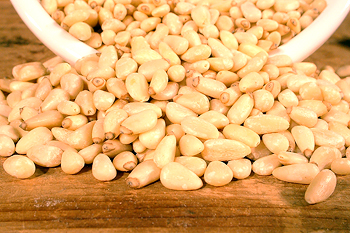 Pine Nuts
Pine Nuts© Denzil Green
Pine Nuts grow on several different varieties of pine trees largely in Italy and Spain. A tree takes 75 years before it is ready to be commercially harvested for its nuts.
Gathering is very time consuming as first you have to gather the pine cones, then extract the nuts from them. The tree that the nuts are most usually harvested from is the “Stone” pine (Pinus pinea), the umbrella-shaped pine tree that you see in pictures of Italy.
The texture of Pine Nuts is slightly waxy. Toasting them gives them a wonderful smoky flavour. In English speaking countries, we have been introduced to Pine Nuts as part of savoury Italian dishes, but they are also used in desserts.
Pine Nuts are very expensive, but it only takes a sprinkle over top a pasta dish to make a difference.
Cooking Tips
If you take the trouble to toast your Pine Nuts, which is always worth the few minutes if and when you have that time, just do it in a skillet without any oil as they have enough of their own. Use a medium or low heat, and watch them, as they will just sit and sit doing nothing and then all of a sudden start to brown. Move them around frequently by shaking the pan, or with a spoon.
Equivalents
1 cup Pine Nuts = 5 oz (140g) in weight
Storage Hints
Pine Nuts are very rich in oil which can go rancid, so store them in the refrigerator or the freezer — you don’t need to thaw them before cooking with them, though you probably would not want to sprinkle Icicle Pine Nuts straight out of the freezer onto your plate of spaghetti.
History Notes
The Ancient Greeks and Romans used Pine Nuts in savoury and sweet dishes, and would preserve them in honey.

